Featured image: The Dakota, by Ajay Suresh
(Creative common license / cc by 2.0)
One of the most common questions novelists are asked is, where do you get your ideas?
For me, and for many writers of historical fiction, inspiration is all around us. It’s on the sidewalks we traverse, the streets we drive, anytime we look outside our windows. That house was built from a 1911 Sears Roebuck catalogue; that bodega used to be a mob hangout in the 1920s; these cobblestones were laid since the 1840s. One small nugget of knowledge about how things used to be can spark an idea, which grows into a story, which can be spun into a novel.
Novelists mine all kinds of sources, and I don’t believe it’s a coincidence that I began writing what turned into the Gilded Gotham Mystery series, set in late nineteenth-century New York, when I worked as a curator at the Brooklyn Historical Society (now the Center for Brooklyn History). Being immersed daily in the history of New York City offered a treasure trove of material, from the nearby stately townhomes built in the 1820s, to the 1880 building where my office was located, to the collections I worked with daily (preserved locks of hair, furniture and teapots, architectural drawings, daguerreotypes, an unidentified femur bone). Of course, it was the mysteries that really intrigued me: why was there a 150 year-old underground tunnel leading to nowhere beneath Atlantic Avenue? How many ghosts haunt the Brooklyn Bridge? Who killed Mary Rogers, the Beautiful Cigar Girl? And whose femur bone was that anyway?
In my second book of the Gilded Gotham Mystery series, Betrayal on the Bowery, I fictionalize multiple real places in New York City, some still extant, others long gone. One is McGurk’s Suicide Hall, which was located at 295 Bowery, run by notorious gangster John McGurk. It gained its grisly reputation honestly, as starting in 1899 it became a place where impoverished young women frequently died by suicide. Another is the Casanova Mansion, torn down sometime around 1900. Built in 1859, it was abandoned by the late nineteenth century, and before its demolition had a reputation for being decidedly haunted. Both locations made great fodder for crafting tricky situations for my protagonists, who find themselves faced with gun-wielding gangsters, bewildering secret passageways, and, of course, multiple mysteries to solve.
In that spirit, I’ve rounded up a group of works—a poem, a short story and several novels—that feature mysterious or haunted New York City locations and happenings. Some are based on actual places, some are fictionalized, but all evoke the rich, deep history of the city and its layers of past life, where there are always a few ghosts knocking around.
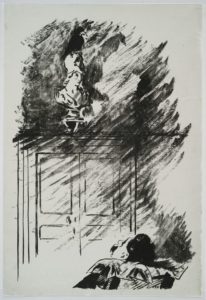
“The Raven,” Edgar Allan Poe (1844)
The OG of the macabre wrote his arguably most well-known work in an upper west side farmhouse on what is now Broadway and West 83rd Street, and the parlor described in the poem apparently matched features of Poe’s writing room in the farmhouse, leading many to speculate the black bird’s ominous visit was meant to have taken place in that location. While the structure that inspired the poem is long gone, the “Raven Mantle,” the mantlepiece from that farmhouse, is now preserved at Columbia University. In lieu of the upper west side farmhouse, though, you can visit the Edgar Allen Poe Cottage in the Bronx, a city and state historical landmark listed on the National Register of Historic Places. Poe and his wife Virginia lived there in 1846-47, and Virginia died in the downstairs bedroom at the young age of 24.
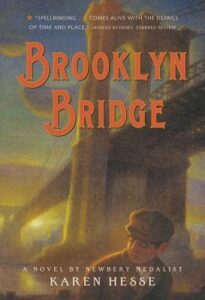
Brooklyn Bridge, Karen Hesse (2011)
The Brooklyn Bridge is considered one of the most haunted structures in the city, as no fewer than twenty people died in its making, including its designer, engineer John Roebling, and eventually his son Washington Roebling, who took over the project. In Hesse’s 1903-set YA novel, it is not the immigrant workers who haunt the bridge, but a child ghost called the “Radiant Boy,” who visits a group of homeless children living underneath the structure. The novel follows the lives of these children and that of fourteen year-old Joseph Mitchom, the son of Russian immigrants. His parents’ recent invention of the teddy bear launches the family into greater financial success but curtails Joseph’s freedom, and the novel intertwines the story of Joseph, the homeless children, and the ghost, eventually solving a mystery and allowing the ghost to rest.
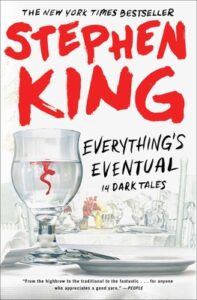
“1408,” Stephen King, in Everything’s Eventual (2002)
The Hotel Dolphin is a fictional place King situated on Sixty-first street near Fifth Avenue, some forty blocks from the Chelsea neighborhood, but in my mind any haunted hotel in New York is always a stand-in for the Hotel Chelsea. There is a disappointing lack of mystery or crime novels set the Hotel Chelsea (Dee Dee Ramone’s Chelsea Horror Hotel notwithstanding, crime writers take note of a very missed opportunity here), but I like to think of King’s short story, in which a writer attempts to spend the night in a haunted hotel room to disastrous, terrifying results, as being inspired by one of the city’s most notoriously haunted locations.
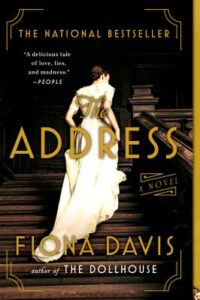
The Address, Fiona Davis (2017)
Another city landmark known for its hauntings is The Dakota, the 1884 landmark, upper west side apartment building. Known for its many ghosts as well as its gabled roofs, balconies, balustrades, and deep dormer windows, The Dakota serves as the titular location of Davis’s novel. The dual timeline shifts between the stories of Sara Smythe in 1884, when the building was opening, and Bailey Cameron, a recovering alcoholic and aspiring designer, in 1985, interweaving the two women’s lives toward a conclusion with a century-old murder at its heart.
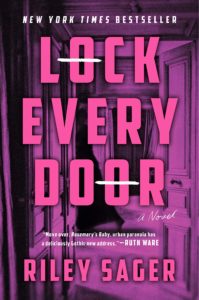
Lock Every Door, Riley Sager (2019)
The New York City apartment building Sager creates, the Bartholomew, has the same kind of panache and mystique as the real-world Dakota. In Sager’s novel, the building caters to the wealthy and the extremely private, and apartment-sitting at the exclusive address seems an ideal temporary job for Jules Larsen, despite the building’s stringent rules. After another apartment sitter, Ingrid, warns Jules that the building isn’t what it seems and subsequently goes missing, Jules begins to investigate. As she learns more about the building’s secrets and how other apartment sitters have disappeared, Jules gets closer to the horrific truth of what the building hides, and learns that if she doesn’t soon escape the Bartholomew, she may never leave.
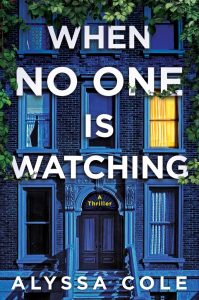
When No One is Watching, Alyssa Cole (2020)
Rather than choose a specific building or site for inspiration, Cole utilizes the all-too common setting of a gentrifying, predominately Black neighborhood in Brooklyn to build a suspenseful and terrifying tale. When protagonist Sydney returns to her Brooklyn neighborhood after a failed marriage to find long-time residents disappearing, for sale signs cropping up everywhere, and new residents participating in the erasure of the area’s past, she and new neighbor Theo begin to investigate. What they find, billed as Get Out meets Rear Window, encapsulates the dislocation and, eventually, horror of an extreme gentrification plan designed to displace local residents at any cost.
***





















